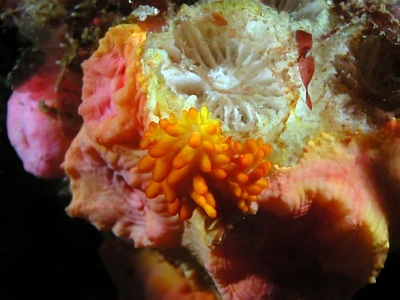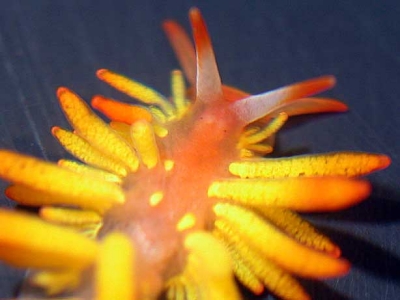Phestilla melanobrachia? from sthn Queensland [1]
December 17, 2008
From: Gary Cobb


Hi Bill and everyone!
During our dives which happen almost every weekend we find many species of Opisthobranchs. One beautiful we see here is Phestilla melanobrachia. The orange and black colourforms. They are always found on Tubastrea sp. (daffodil or sunshine coral) it's food source. We sometimes find it on the substrate below overhangs were the coral lives. Where we think it has been knocked off. We also found the two colour forms on the same coral! One coral group yielded 4 animals, 3 orange and one black. On collecting them for study and taxonomic photos we noticed they love to trail each other! The largest one always in the front.
Locality: Mooloolaba, Sunshine Coast, 16m, Queensland, Australia, Pacific Ocean, 26 April 2008, Subtidal. Length: 10-30mm. Photographer: Gary Cobb and David Mullins.
Cheers
Gary
gary@nudibranch.com.au
Cobb, G.C., 2008 (Dec 17) Phestilla melanobrachia? from sthn Queensland [1]. [Message in] Sea Slug Forum. Australian Museum, Sydney. Available from http://www.seaslugforum.net/find/22016
Dear Gary,
Thanks for these observations and photos. Interestingly, I list two papers by Larry Harris on the species' Fact Sheet where he describes the behaviour of this species in Singapore and how they are usually found on broken off - but still live - pieces of Tubastrea found in the sand beneath overhanging colonies, exactly as you describe from sthn Queensland.
I would be interested in more observations on the colour forms and the corals they are living on. I have always assumed the colour forms would be found on corals of a matching colour, as the colour of the digestive gland is rather dependent on the food colour. If your animals are living on broken off fragments perhaps this means they have to change from one fragment to another as they eat it clean. If so, perhaps they change colour as they eat from a new fragment of a different colour. It would be interesting to hear of your observations on this point. Perhaps you have seen animals in the process of going from yellow to black or vice versa? Thanks also for the photos in your accompanying message [#22017].
Best wishes,
Bill Rudman
Related messages
-
Who can identify?
From: Carmen Obrist, December 23, 2009 -
Phestilla melanobrachia from Indonesia
From: Helene Caillaud, November 25, 2009 -
Phestilla melanobrachia from Thailand, with parasites
From: Marcel Tanke, February 9, 2009 -
Phestilla melanobrachia from sthn Queensland [2]
From: Gary Cobb, December 17, 2008 -
Phestilla melanobrachia? from Singapore
From: Toh Chay Hoon, November 3, 2008 -
Parasites on Phestilla melanobranchia
From: Jon Bertsch, November 21, 2007 -
Phestilla melanobrachia from Bali
From: Mike Krampf, August 8, 2007 -
Re: Phestilla melanobrachia from Hong Kong
From: Curt Swearingen, July 25, 2007 -
Phestilla melanobrachia from the Red Sea
From: Sven Kahlbrock, June 4, 2007 -
Phestilla from the NOAA website
From: Frances Clements, August 2, 2005 -
Phestilla melanobrachia with parasites
From: Roberto Sozzani, February 21, 2005 -
Phestilla melanobrachia from Reunion Island
From: Philibert Bidgrain, February 19, 2005 -
Phestilla melanobrachia from the Solomon Ids
From: Bruce Potter, July 21, 2004 -
Phestilla melanobrachia in East Pacific
From: Alicia Hermosillo, September 6, 2003 -
Phestilla melanobrachia & parasites
From: Lisa Malachowsky, May 12, 2003 -
Phestilla melanobrachia from Myanmar
From: Mary Jane Adams, March 25, 2003 -
Phestilla melanobrachia from Malaysia
From: Kheong Sann Chan, April 18, 2002 -
Phestilla melanobrachia from Hong Kong
From: Leslie Chan, July 17, 2001 -
Phestilla melanobrachia from Hong Kong
From: Bill Rudman & Brian Darvell, July 17, 2001
